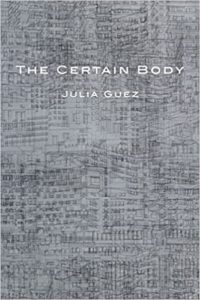A REVIEW OF JULIA GUEZ’S THE CERTAIN BODY
The Certain Body, Julia Guez. Four Way Books, 2022. 64 pages. $17.95
by Charles Kell
Julia Guez’s second collection, The Certain Body, is a singular, stunning look at our contemporary moment. It investigates varying experiences with the body: the body as site of illness; the body as locus of experience and time; our relationship to past bodies; how one’s corporality engenders emotional, psychological, and philosophical thoughts; and, ultimately, how the body can continue as a site of pleasure. The Certain Body is a text that deepens upon each reading, demonstrating something unique in contemporary poetry: it is simultaneously a text of the moment, of our time, while invoking the past and also the future.
In the opening poem, “Meditation at Callicoon,” the speaker feels the pressing of time, the transience of being and life:
More and more night pretends
it isn’t spring. What to
make of the daffodils then?
Hyacinth here and there, wind
and rain? So many birds.
There is the darkness pressing balanced with the focus on the surrounding flowers, the weather. The physical recognitions occupy an in-between space in this sonnet. There is the passing of time, the interior / exterior meditation. The questions of what “to make” of life going on, moving forward. Nature—the birds, the flowers, will soon be gone:
Of course they won’t stay
long. None of this will.
Not the night, the cold,
the city full of swallows.
Not the bridge and rivers.
The poem, heretofore a meditation on the ephemerality of time, of life, bends toward an ecological statement, before the end that zooms back to a specified, personal moment of what else will not last:
Not even mothers and sons
this would be unbearable without.
This opening poem, in stunning manner, balances grand statement with the sustained attention on ordinary life; its moments. The speaker practices the ability to equally be inside the experience, take it into account and also step outside—if that is even possible—to look at the melancholy fact that all this—everything—will soon be over.
Guez’s ability to do all these things at once, in imagistic and crystalline language, is one of the most stirring aspects of this collection.
In the title poem, transience is balanced and experienced through creation, through thinking about the process of making:
Each taking months to
sand, surfaces made aware
of their own precarity
and also the miracle
of them being here
in this museum
What’s striking about this opening is the focus on art, which gives way to the body and existence. There are equal parts fragility and sturdiness. The ekphrastic encounters in this collection are manifold and push beyond surface down toward multiple layers of feeling and thinking. What opens as a meditation on Vija Celmins swerves and juts to both the poet’s practice of making and the practice of living.
This practice moves and takes on different resonances when illness overrides the body. In “If Indeed I Am Ill,” the speaker implores: “Tell me about London, the weather there / in spring outside the walls of the Great Hall.” The interlocutor’s voice is likened to “sonatas,” “scores” that will “tell me / what of them will last when everything falls away— ”; here, it is the sound of a voice that carries and buoys the speaker.
“In a New Form,” a powerful meditation, dailiness is magnified, the momentary struggle is experienced; a different way of being and looking is attempted and is a necessity. The opening reads:
She’s not taking her temperature first thing in the morning, not the
way she was before.
The slow passing of a cortège in March sleet, the poverty.
The thermometer is on my windowsill now.
Here, again, sickness is experienced in slow motion. The thermometer takes on enormous weight:
It used to sit on the convex
frame of a mirror hanging
on her side of this
bed we haven’t shared in weeks.
These details and attention to objects point toward an extreme reckoning with the present; things, life are different now.
“In a New Form” fascinates—its structure and shape, its single lines and stanzas. In the poem, every indentation signals a line from “You, Very Young in New York,” “Repeat Until Time,” or “The Sandpit After Rain,” from Hannah Sullivan’s Three Poems (2018). Like the title poem, Guez’s interaction and intertextual engagement with art—whether it painting, sculpture, poetry—practices a deep and integral layering. Time both stops and flies by; nothing is as it was before. Life, health, being are precarious; therefore, an attention, a new form of creation is needed.
The poem powerfully closes the first section of the book and in many ways works as a map, a guide, a blueprint, an actual practice of what follows. Another startling element of Guez’s new book is its form, its tight structure, while simultaneously feeling free, extremely expansive; there are multitudes of space; it breathes over and again. Sometimes, mimicking sickness, the breath is tight, labored; in other moments, as in the opening poem of section two, “A More Onerous Citizenship,” there is a marked expansiveness, white space at work, the movement of each line puts into specific practice a new mode of forwardness. Each of the five sections zoom in and expands on themes from the opening. Each section is titled for a day of the week, starting with Wednesday and ending on Sunday; bodies, sickness, art, longing, breathing, the dead. Part IV., Saturday, reads in its entirety:
Between that disgust and this
one, a vigil;
the dark has never been final.
The last line gives way to part V. Sunday, where, in tightly expressive and imagistic tercets, the speaker turns toward night:
Night is a time of quiet then:
a time to sort, to make bargains,
promises and plans
even if they’re all provisional.
Night is a time to weep
without the children there to see
and when the weeping is over,
night is a time to read and write.
In these lines night is all encompassing and a place of artful work, artful living and solace. It works as shelter and place of thinking, creating, reflecting. There is also a turn here, later, where the body becomes, again, a site of pleasure:
the mouth’s wet
vestibule, warm and red baring
brass and wind,
Glenlivet and cunnilingus
whispering
the same words across time
into the same ear
bringing itself so close
Guez’s collection is a book written on the body; it is a palimpsest of art, feeling, living with sickness, and the multiple swirling creations that come from these experiences. It is a deeply personal book and also equally concerned with society, the lives other people live. The final three poems work, to me, as a triptych of sorts. In “On the Occasion of My Half-Birthday,” the speaker’s attention is turned toward the sensory, nature, survival, and continuing with life:
Thyme out in the window box,
wildness and splay of what has always survived winter here,
fasting only to re-emerge greener in the spring.
All I want is the sun on my face.
Here, the speaker revels in the present, in the greenery and light, the “park where I take our children to play”; while there is also acknowledgment in “knowing months and years disappear // like so many Simeons—”
The transience is what situates this moment as transcendent. In the penultimate poem, “Hymn, Then,” the speaker meditates on the murder of George Floyd. This startling poem is both somber and boiling, elegy and call to action. Here is the poem in full:
Hymn, Then
after Jammie Holmes
It is the please, George.
As in, asking these in-
tolerable things to be
other than what
they have always been
and but politely.
Inside the throat,
a hymn then
one May when
the sun refused
to shine on
the final please
hanging above the city
for all to see
the certain body
gathering force in-
struments of war,
weather—heat now
rain—hate, even
a plague cannot contain.
The body of Floyd, the language, movement—both of mourning and protest. The note relates that the poem is after Jammie Holmes, the artist who created the public art piece, They’re Going to Kill Me (2020), which consisted of airplanes carrying banners, five days after the killing of Floyd, across Detroit, Miami, Dallas, Los Angeles, and New York between the hours of 11:30 a.m. and 9:00 p.m. with George Floyd’s final words: “They’re going to kill me.” and “My neck hurts.”
Guez’s poem enacts a pause in the reader, a slowing down. One again thinks of breath; however, its resonances are different. Floyd’s body, images of Floyd, something palpable, building, “even / a plague cannot contain.”
The final poem, “Forty,” is time turning: “All the purple flowers / the way they fall, / white and purple, falling.” A cascade of image, color, slow petals falling silently: “make / no sound, beginning soon / to yellow then brown.” The ending emphasizes time, life, death; yet there is transcendence in close attention, in language, in being present, in creating, in being a witness to everything. Guez’s collection is a deep encounter with life, with death, with sickness, with creation. There are specific encounters with the personal body and the public. The Certain Body is simultaneously a swift book, read in a breath, while also dense, deep, and learned; it’s a book that rewards multiple readings, with spending time and living with it. Guez’s second book is a powerful follow to her first, In an Invisible Glass Case Which Is Also a Frame (2019), building and expanding—Julia Guez is carving out one of the singular bodies of work in contemporary poetry.

